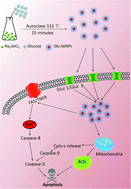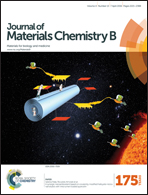Facile synthesis of highly uniform selenium nanoparticles using glucose as the reductant and surface decorator to induce cancer cell apoptosis
Abstract
Selenium nanoparticles (SeNPs) have attracted increasing attention due to their potential application as an effective drug delivery system. However, the conventional synthetic methods are mostly confined to solution-based synthesis that are time consuming and with low efficiency. Herein, we demonstrate the facile synthesis of highly uniform SeNPs using glucose as the reductant and surface decorator (Glu–SeNPs) that could induce cancer cell apoptosis. Glucose was used as the reducing agent to reduce sodium selenite (Na2SeO3) at high temperature (115 °C), which also acted as the surface decorator of SeNPs to prevent aggregation in an aqueous solution, thus enhancing its stability under physiological conditions. The functionalized nanoparticles demonstrated high hemocompatibility and showed selective cytotoxicity towards various human cancer cells, but not normal cells, through induction of apoptosis by initiating both intrinsic and extrinsic pathways. Furthermore, studies on the action mechanisms revealed that internalized Glu–SeNPs significantly and rapidly triggered intracellular ROS overproduction and mitochondria dysfunction to regulate the cell fate. Taken together, this study provides a new and effective method for facile synthesis of SeNPs possessing potent anticancer efficacy.


 Please wait while we load your content...
Please wait while we load your content...